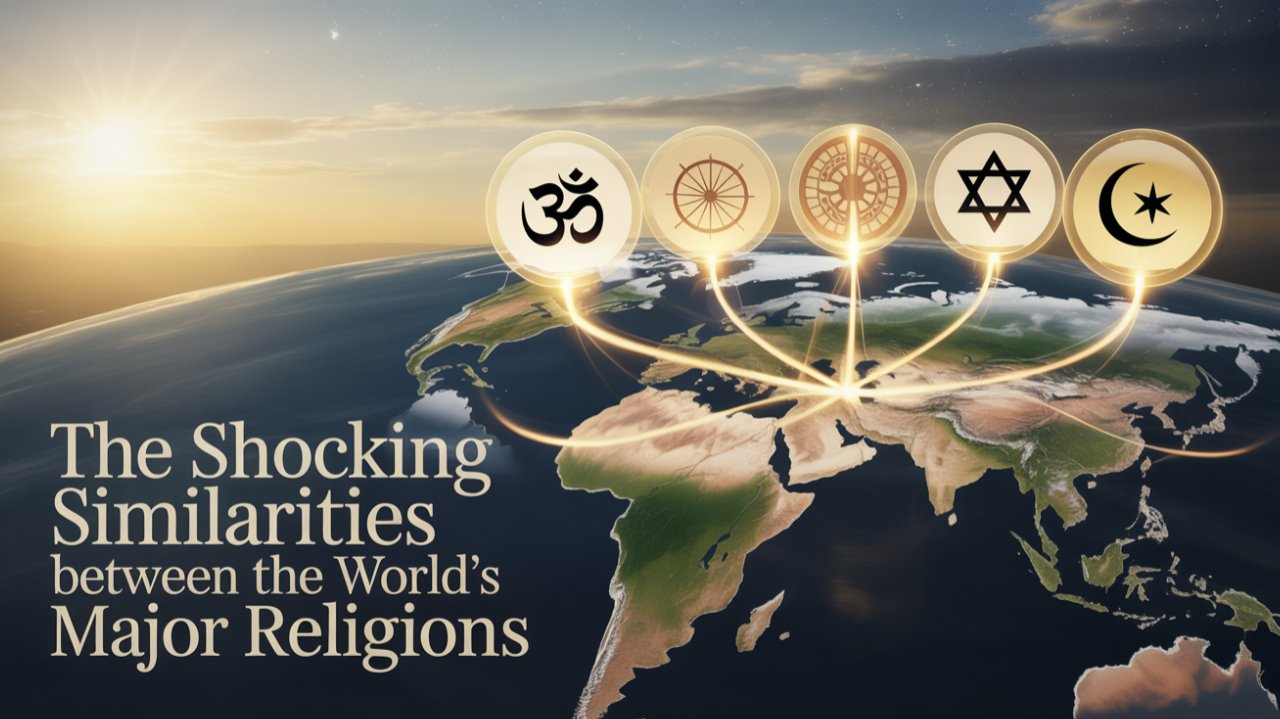Most of us have been taught to see the world’s major religions as fundamentally separate, even competing, belief systems. We draw these sharp lines in the sand: this is Hinduism, this is Buddhism; this is Judaism, this is Christianity, this is Islam. We see different prophets, different books, different rules, and a history of conflict that seems to confirm they just don’t mix.
But what if that’s not the whole story?
What if I told you that these great faiths, which have shaped billions of lives, share a kind of hidden historical DNA? A common ancestry that, when you trace it back, reveals a surprisingly shared past. What if the stories, the laws, and the very ideas we think of as unique to one faith are actually echoes, bouncing from one tradition to the next, across continents and centuries?
Today, we’re going to unravel that DNA. We’re going on a journey to uncover the startling similarities in their origins, their prophets, and their most sacred ideas. These connections tell a deeper, more unified story of humanity’s search for meaning. What we’ll find is that the world’s great religions aren’t isolated islands, but more like interconnected continents, all part of one human world.
The Ancient Tapestry – Hinduism
Our journey starts by traveling way back in time, further than any other major living religion, to the Indian subcontinent. Here, we don’t find a single founder or one big moment of revelation. Instead, we find Hinduism, a faith that’s less like a statue carved by one artist and more like a vast, intricate tapestry woven by countless hands over thousands of years. It’s often called the oldest living religion on Earth, with roots stretching back over 4,000 years.
The story begins in the Indus Valley Civilization, one of the world’s first great urban cultures, which was flourishing around 2500 BCE. Archaeologists digging in the ruins of cities like Harappa and Mohenjo-Daro have found clues pointing to the deep origins of Hindu practice. They’ve found seals with figures in meditative poses that look a lot like the god Shiva. They’ve discovered terracotta figurines of mother goddesses, hinting at an early focus on the divine feminine that’s still central to Hinduism. There’s even evidence of deep respect for water and ritual bathing, a practice you can still see today in the sacred ghats of the Ganges River.
Then, around 1700 BCE, a new cultural wave swept in. Aryan tribes migrated from the north, bringing their own traditions and a collection of sacred hymns called the Vedas. This wasn’t a replacement; it was a merger. The beliefs of the Indus Valley people fused with the Vedic traditions, creating the dynamic synthesis that became the bedrock of Hinduism. And this is a key piece of our puzzle it shows that religions aren’t born in a vacuum. They emerge from a rich soup of cultures and ideas that already exist.
From this ancient origin, Hinduism developed ideas that would not only define it but also cast a long shadow, influencing the faiths that came after. One of the most basic is the idea of Dharma. It’s often translated as ‘duty’, but it’s a much bigger concept: it’s the cosmic law, the underlying order of the universe, and the righteous path people must follow to be in harmony with it. This idea of a divine, cosmic law guiding human action is a theme we’ll see pop up again and again.
Another core concept is Karma, the universal law of cause and effect, where every action and thought has consequences. Linked to this is Samsara, the continuous cycle of birth, death, and reincarnation. Life isn’t a one-shot deal, but a journey of the soul through countless existences, with the ultimate goal being Moksha liberation from this endless cycle.
And how does the divine get involved? Through Avatars. Hinduism teaches that the supreme being, Vishnu, comes down to Earth in various forms as a fish, a warrior, a king to restore Dharma and guide humanity. This concept of a divine being entering the human world with a message is a powerful archetype we will definitely see again.
What’s essential to grasp about Hinduism is that it doesn’t have a single origin story. There’s no Moses or Muhammad. It’s a cumulative tradition, a library of wisdom gathered over ages. This makes it the perfect starting point for our investigation. It’s the ancient, foundational block of our “historical DNA,” containing the raw materials cosmic law, life cycles, and divine messengers that will be built upon and reinterpreted by the religions that follow. It establishes our first major pattern: religions build on the spiritual world that came before them.
The Path of Enlightenment – Buddhism
From that spiritual landscape in India, our story moves to a pivotal moment around the late 6th or early 5th century BCE. The ideas of Hinduism Karma, Samsara, and Dharma are deeply embedded in the culture. But it’s also a time of questioning. The complex rituals of the priests and the rigid caste system left many searching for a more personal path to truth. It’s out of this very context, not as a totally new invention but as a reform movement, that Buddhism is born.
And here, we meet our first major founder, a man whose story has become a legendary archetype: Prince Siddhartha Gautama. He was born into a life of unbelievable luxury, shielded from any knowledge of suffering. But his world was shattered when he went outside his palace and saw, for the first time, an old man, a sick person, a corpse, and a wandering holy man. Haunted by this, he made a radical choice. He gave up his title, his wealth, and his family to find an end to suffering itself.
Siddhartha’s journey is a powerful example of another pattern we’ll see: the reformer who, driven by a deep spiritual crisis, breaks from tradition to forge a new path. For years, he practiced extreme self-denial, nearly starving himself to death, but found it didn’t work. Finally, while meditating under a Bodhi tree, he discovered the “Middle Way” a path of moderation. It was there that he became the Buddha, the “Enlightened One.”
What’s fascinating is how the Buddha took the existing “DNA” of Hinduism and reinterpreted it. He didn’t erase the old concepts; he repurposed them. Karma and Samsara, the cycle of rebirth, were still central. Your actions still determined your future. However, the goal was no longer to merge your soul, or Atman, with a universal spirit. In a radical shift, the Buddha taught Anatta, or “no-self.” He argued there is no permanent, unchanging soul. Liberation, or Nirvana, wasn’t about uniting a self with God, but about extinguishing the very flame of desire that causes suffering and keeps the cycle of rebirth going.
He also took the concept of Dharma and gave it a new spin. For Hindus, it was the cosmic order. For Buddhists, Dharma became the specific teachings of the Buddha himself the universal truths he had discovered. His core teachings, the Four Noble Truths, are like a doctor’s diagnosis for the human condition: life is suffering, suffering comes from craving, we can end that suffering, and the way to do it is the Noble Eightfold Path.
This “path” is another recurring theme. Buddhism offered a clear, practical guide right understanding, right thought, right speech, and so on. It was a path open to anyone, regardless of their caste, which was a direct challenge to the priestly system. The Buddha essentially democratized enlightenment. He taught that the key to salvation wasn’t fancy ceremonies, but training your own mind and living ethically.
So, in Buddhism, we see our shared DNA evolve. It inherited the cosmology of its parent religion but reformed it. It kept the building blocks of Karma and rebirth but changed the endgame. It introduced the powerful archetype of the single founder a human who achieves divine wisdom and shows others the way. And it crystallized the idea of a “path” as the central metaphor for a life of faith. The story is no longer just a tapestry woven by many; it’s now also the hero’s journey, a path for others to follow.
The Covenant and the Law – Judaism
Now we’re going to leap across geography and philosophy, from the spiritual landscape of India to the arid deserts of the Middle East. This region was a crucible of civilizations, a crossroads for empires like Egypt and Mesopotamia. It’s here that a radical, world-changing idea took hold: monotheism. And its first champion was Judaism.
Unlike the slow weaving of Hinduism, Judaism traces its roots to a specific family line and a foundational event: a covenant. The story begins with one person, Abraham, a nomad from the city of Ur, who is called by a single God to travel to a promised land. In return for his faith, God promises to make Abraham’s descendants a great nation. This is the covenant: a binding agreement between God and humanity. It’s a shift from the impersonal cosmic laws of the East to a personal God who gets directly involved in human history.
This introduces a new element to our “historical DNA”: the idea of a chosen people, bound by a sacred contract. The story continues with Abraham’s grandson, Jacob, who is renamed Israel, and his twelve sons, who become the ancestors of the twelve tribes. Their story leads them to Egypt, where they become slaves a period of shared suffering that sets the stage for their defining moment of freedom.
This brings us to the second key figure: Moses. Here again, we see the archetype of the hero and reformer, called by God to lead his people out of slavery. The story of the Exodus the plagues, the parting of the Red Sea, the journey through the wilderness is the central epic of Judaism. It’s a story of a God who acts to bring justice and freedom to the oppressed.
But the journey doesn’t end with freedom. On Mount Sinai, Moses receives God’s law, the Torah, including the Ten Commandments. This is another critical moment for our shared religious DNA. While Hinduism has Dharma and Buddhism has the Eightfold Path, Judaism introduces the concept of divine law as a written code that governs every part of life. The Torah becomes the sacred text, the literal word of God that forms the constitution for the Israelite people. This intense focus on a holy book as the ultimate authority is a pattern that will become hugely important later on.
But it’s important to remember, Judaism didn’t appear out of nowhere. It was shaped by its world. The story of Noah’s Ark, for example, has striking similarities to much older Mesopotamian myths like the Epic of Gilgamesh. This doesn’t take away from its religious meaning; it just shows that the ancient Israelites were part of a larger cultural conversation, using familiar story templates to express their unique vision of God.
Later, during the Babylonian Exile in the 6th century BCE, Jewish leaders were forced to live in Babylon. It’s here that many scholars believe Judaism was influenced by another powerful faith: Zoroastrianism. This remains a topic of academic debate, but the theory is compelling. Zoroastrianism had a strong dualistic worldview a cosmic fight between a god of good and a spirit of evil. It also had well-developed ideas about angels, demons, a final judgment, and a heaven and hell. Before this period, Jewish texts had a much vaguer idea of the afterlife. After the exile, Jewish thought shows a clearer belief in resurrection and a final judgment ideas that would become absolutely central to the religions that later grew from Judaism’s soil.
In Judaism, we see several key genetic markers come together. We have the personal, monotheistic God. We have the central figures of the patriarch (Abraham) and the lawgiver (Moses). We have the idea of a covenant, a sacred text as the final word, and a detailed divine law. And we see how this tradition, while forging its own identity, also absorbed and re-purposed stories and ideas from the wider world, creating a powerful new synthesis that would set the stage for our next chapter.
The Son and the Salvation – Christianity
From the ancient Near East, our story moves into the Roman Empire in the 1st century CE. The land of Judea, the Jewish heartland, is under Roman occupation. The Jewish religion is buzzing with different groups debating how best to live by the Torah. It’s into this politically charged and spiritually vibrant world that Christianity is born not as a new religion, but as a revolutionary movement within Judaism.
At the center of it all is a figure who fits the founder-reformer archetype in a dramatic new way: Jesus of Nazareth. To understand Jesus, you have to first see him as a 1st-century Jew. He was a rabbi who taught Jewish crowds in Jewish synagogues. His teachings were soaked in the Hebrew scriptures. When he summarized God’s law, he quoted the Torah directly: “You shall love the Lord your God with all your heart,” and “you shall love your neighbor as yourself.” He spoke of the “Kingdom of God,” a concept deeply rooted in Jewish hopes for a future age of divine justice.
In its earliest form, Christianity didn’t see itself as a break from Judaism, but as its fulfillment. The first followers of Jesus were all Jews who believed he was the Messiah the “anointed one” promised in their scriptures. They continued to worship at the Temple in Jerusalem and follow Jewish law. The radical new belief that set them apart was their conviction that Jesus, after being crucified by the Romans, had been resurrected from the dead.
And this is where that DNA we’ve been tracing from Judaism gets a fascinating twist. Christianity takes the core components of its parent faith and reinterprets them through Jesus. The Hebrew Bible isn’t thrown out; it becomes the “Old Testament,” read as a story that points directly to Jesus. The covenant given to Moses is seen as fulfilled by a “New Covenant,” sealed not on stone tablets, but in the person of Christ.
The concept of divine law is also transformed. Especially through the influence of the Apostle Paul, salvation was no longer seen as coming from strict adherence to the Torah’s laws, but through faith in Jesus as a savior whose death paid for the sins of humanity. This change opened the door for the movement to spread. Non-Jews, or Gentiles, could join without having to adopt all the ritual laws of Judaism.
The very nature of God is also redefined. While holding firm to monotheism, Christianity developed the doctrine of the Trinity: the belief that the one God exists as three persons the Father, the Son (Jesus), and the Holy Spirit. This idea of God becoming human the Incarnation is a unique and radical step. While other traditions, like Hinduism with its avatars, feature divine beings entering the human world, the Christian concept of God himself becoming human as a core tenet of monotheism was a profound development.
Christianity also took the ideas about the afterlife that had developed in later Judaism the resurrection, a final judgment, heaven and hell and made them central pillars of its theology. The cosmic struggle between God and Satan, good and evil, became a core part of the story.
Christianity’s story is one of dramatic inheritance and transformation. It’s born as a child of Judaism, sharing its God, scriptures, ethics, and messianic hopes. But it reimagines that inheritance in a way that gives it a unique identity and a universal appeal, allowing it to spread far beyond its birthplace. It shows, maybe more clearly than any other example, how a new faith can emerge directly from the womb of an old one, carrying its genetic code but growing into something entirely new.
The Final Revelation – Islam
For the final piece of our story, we travel to the Arabian Peninsula in the 7th century CE. This was another great crossroads, a land of deserts and trade routes connecting the great Byzantine and Persian Empires. And it wasn’t a spiritual vacuum. There were many local polytheistic traditions, but also thriving communities of both Jews and Christians. The stories of Abraham, Moses, and Jesus were in the air. It’s in this environment, steeped in the monotheistic traditions that came before, that Islam appears.
The story begins with a man named Muhammad, a merchant from Mecca known for his honesty. In his forties, while meditating in a cave, he received his first revelation. The angel Gabriel appeared and commanded him to “Recite!” This was the start of a 23-year period where Muhammad would receive messages from God, or Allah in Arabic. These revelations, written down by his followers, became the sacred scripture of Islam: the Qur’an.
From the very beginning, Islam presents itself not as a new religion, but as the completion and final correction of the same faith that was revealed to earlier prophets. The Qur’an says its message is the same essential faith taught by a long line of prophets, including Adam, Noah, Abraham, Moses, and Jesus. These figures aren’t just acknowledged; they are honored as great prophets of Islam.
This is the most direct and explicit sharing of “historical DNA” we have seen yet. The foundational stories of Judaism and Christianity are also foundational to Islam. The Qur’an has detailed accounts of Adam and Eve, Noah’s ark, the covenant with Abraham, the exodus from Egypt, and the virgin birth of Jesus. Islam sees itself as the final branch on this single “Abrahamic” family tree.
At its core, Islam is built on a radical, uncompromising monotheism known as Tawhid the absolute oneness of God. This is a powerful echo of the strict monotheism of Judaism. And while it honors Jesus as a great prophet, Islam rejects the Christian doctrine of his divinity, seeing it as a violation of God’s absolute oneness.
Like Judaism and Christianity, Islam is a religion of the book. The Qur’an is considered the direct, literal, and unchangeable word of God, revealed to the final prophet, Muhammad. This gives the text an unmatched authority in the life of a Muslim. And, like in Judaism, this sacred text is the basis for a comprehensive system of divine law, the Shari’ah, which guides everything from prayer to social justice. This idea of a holy “path” or “law” is a powerful continuation of the theme we’ve been tracing.
Islam also arose in response to the social problems of its time. 7th-century Mecca was a society plagued by tribal warfare and economic inequality. The Qur’an’s message was revolutionary. It called for an end to tribal divisions and the creation of a single community, or Ummah, based on faith, not blood. It commanded believers to care for the poor and orphaned. This theme a faith rising to fix the social ills of its day is a pattern we also saw with Buddhism and Christianity.
The archetypes we’ve been following are all here in Islam. Muhammad is the final founder-reformer, the “Seal of the Prophets,” who receives a divine revelation and leads his community from persecution to victory. The hero’s journey is clear in his migration, or Hijra, from Mecca to Medina to escape persecution an event so important it marks the beginning of the Islamic calendar.
In Islam, our “historical DNA” comes full circle. It consciously and deliberately weaves together the threads of the Abrahamic faiths, creating a powerful system of belief that sees itself as the culmination of one single, continuous story of God’s revelation to humanity.
The Synthesis – Unraveling the Shared DNA
So, after traveling through thousands of years of history, what have we found? The shocking similarities between these religions aren’t just coincidences. They are patterns, archetypes, and ideas, passed down and reinterpreted, forming a shared spiritual heritage for a huge portion of humanity.
First, we see the clear archetype of the Founder and Reformer. While Hinduism’s origins are spread out, the other four faiths are defined by a central figure who, usually in response to a crisis, lays out a new path. Siddhartha leaves his palace to end suffering. Moses leads his people from slavery and receives the law. Jesus challenges religious authorities and offers a new covenant. Muhammad receives a revelation that calls his society back to pure monotheism. These figures often follow the classic “hero’s journey.”
Second, there is the incredible importance of the Sacred Text. Each tradition eventually codified its beliefs into a central scripture. The Vedas in Hinduism, the Tripitaka especially in Theravada Buddhism the Torah in Judaism, the Bible in Christianity, and the Qur’an in Islam all serve as the primary source of doctrine and identity. The act of writing down a divine message is a crucial step in forming a religion that lasts.
Third, we find the universal ethical principle known as The Golden Rule. Despite huge theological differences, the core idea of treating others as you want to be treated is a common thread. Now, the exact wording and the emphasis might change, but the core sentiment is astonishingly consistent:
From Hinduism: “One should not behave toward others in a way which is disagreeable to oneself.”
From Buddhism: “Hurt not others with that which pains yourself.”
From Judaism: “What is hateful to you, do not do to your fellow.”
From Christianity: “So in everything, do to others what you would have them do to you.”
From Islam: “None of you [truly] believes until he loves for his brother that which he loves for himself.” This remarkable consensus points to a shared bedrock of human morality.
Fourth, we see the recurring motif of the Divine Messenger. Whether it’s a Hindu Avatar descending to restore order, a Buddhist Bodhisattva delaying nirvana to help others, or an Abrahamic Prophet receiving a revelation from God, there’s a consistent belief that the divine communicates with us through chosen individuals.
Finally, we find Shared Narratives and Concepts. The most striking example is the Great Flood myth, which shows up in ancient Mesopotamia, in the Hindu story of Manu, and in the Abrahamic story of Noah’s Ark. We also see the concept of a “Path” or “Way” as a central metaphor: the Hindu Dharma, the Buddhist Eightfold Path, the Jewish Halakha (“the way to walk”), Jesus as “the Way, the Truth, and the Life,” and the Islamic Shari’ah (“the path to water”). All of these point to religion as not just a set of beliefs, but a journey and a way of life.
Seeing these faiths laid out side-by-side, it’s pretty clear their histories aren’t separate, but deeply tangled. They grew in conversation with one another responding to, borrowing from, and reforming the ideas that came before. They aren’t isolated monoliths, but branches on a vast, sprawling tree of human spirituality.
So what does this all mean for us today?
In a world so often fractured by religious division, understanding this shared heritage feels more important than ever. It doesn’t erase the real and significant differences between these traditions differences that are worth understanding and respecting. But it does challenge the story that they are fundamentally alien to one another.
Recognizing this common DNA allows us to see the history of religion not as a history of conflict, but as a shared human quest. A multigenerational, multicultural search for answers to the biggest questions: Why are we here? How should we live? And what is our relationship to the universe and to each other?
The similarities we’ve explored are a powerful reminder that beneath the diverse rituals and doctrines, there is a common human impulse the desire for meaning, the need for community, and the call to live a more compassionate life. Perhaps by understanding our surprisingly shared past, we can build a more understanding and unified future.
I’m curious what you think. What other similarities between the world’s religions have you noticed? Share your thoughts in the comments below. And if you found this journey through our shared history fascinating, consider subscribing for more explorations into the stories that shape our world. Thanks for watching.





